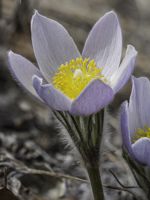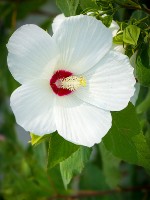Mon-Fri 9am - 5pm Mountain time
Swamp Rose Mallow (Hibiscus) vs Prairie Crocus
Pulsatilla nuttalliana (Anemone patens)
Hibiscus moscheutos
NOT AVAILABLE THIS SEASON - MIGHT RETURN
NOT AVAILABLE THIS SEASON - MIGHT RETURN
Prairie Crocus is a native perennial wildflower that is often considered one of the first signs of spring. The flowers can range from purple, pale blue, to white and often appear before the snow has fully melted. It can bloom a month earlier than other spring flowers, providing an early source of pollen for a variety of pollinators.
The plant is covered in woolly white hairs, including the finely divided leaves, giving them a silvery appearance. Prairie Crocus leaves do not fully emerge until after it has bloomed. The spent blooms transform into fluffy, feathery seed heads. During the hot summer months, the Prairie Crocus goes dormant and will repeat its life cycle the following spring.
The Prairie Crocus is Manitoba’s provincial flower.
Swamp Rose Mallow (Hibiscus) has large white-pink showy flowers which attract hummingbirds and pollinators to your yard. It is a tall, fast growing perennial shrub. The flowers typically only last 1-2 days, but the plant will continue to rebloom throughout the season.
This hibiscus tolerates heat and humidity but does not do well when exposed to wind. Make sure the plant has access to lots of moisture for better flowering.
The Swamp Rose Mallow (Hibiscus) is also known as the dinner plate hibiscus because it can grow incredibly large flowers, as big as dinner plates.
Prairie Crocus Quick Facts
Swamp Rose Mallow (Hibiscus) Quick Facts
Toxicity: all parts toxic if eaten, sap can irritate skin

